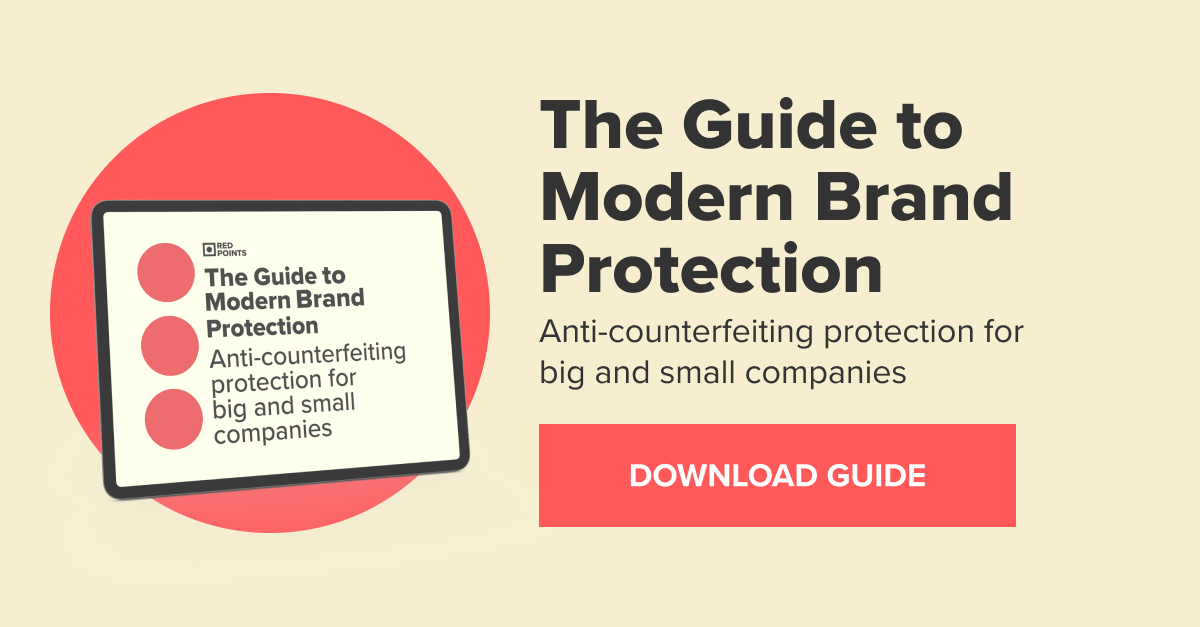📌 Get the latest strategies to protect your revenue in your inbox

Table of Contents:
Last updated on: June 8, 2022
Brand protection tends to focus on removing products sold online, but knowing how to stop counterfeits crossing the border can provide a huge boost to your strategy.
Customs and Border Protection (CBP), a branch of the Department of Homeland Security, is a vital part of the United States’s anti-counterfeiting process, and is the best way for American brands to integrate government resources into their own brand protection.
The CBP has the ability to search any vehicles and their cargo attempting to cross the US border. If suspected counterfeit products are found, they have the authority to detain and seize those products. Once seized, the CBP will give the importer five days to respond to the seizure, and soon after may contact the trademark owner for involvement in the examination of the suspected products for authenticity.
Once infringing products have been identified and validated, the IP holder typically has two options for brand protection: to have the goods destroyed, and to establish legal action against those infringing the IP.
Following these actions has a number of benefits. Immediately, it removes a number of counterfeit products and prevents them from being sold. In the longer term, it signals to the CBP that the brand is truly committed to protecting their IP. It also gives an opportunity to contact the individuals responsible for the counterfeits, granting invaluable information for brand protection.
It’s highly recommended that brands educate the CBP about their products to help them better identify potentially fake products and to keep them alert for suspicious activity. Relevant details to share include:
In short, any method that brands employ to educate these customs officials about their products will be helpful for a brand protection strategy. There are a couple of ways of actually going about doing this, and the best solution would be to use a combination of these two methods.
A product guide is a popular method for educating CBP officials. It’s a permanent handbook, full of relevant details and image examples, which can always be referred back to when suspected fakes products arrive at the border. The CBP has a useful template for brands to create their own product guide, accessible here.
The other option is to use live training events, most commonly seen in the form of webinars but also as in-person seminars. The benefits of hosting a webinar are many, including zero travel cost, no upper limit to the number of attendees and the ability to keep a recorded version for future employees.
In order to have a brand protection strategy that includes the CBP, or whichever customs/border agency exists in your country, the first step is to record your intellectual property (IP) with them. The IP that can be recorded is limited to trademarks and copyrights which have already been registered in the US.
The process of Customs trademark recordation costs $190 per each copyright recordation applied for, and for each International Class of goods for trademarks. Recordation can be filed simply on the CBP website, accessible here.
Once the IP is recorded, it generally lasts for one year and may be renewed through the same portal as the original recordation.
In fact, most countries have processes similar to that of the US, and it’s important for brands to understand the processes for each country they with to enforce their IP in.
Though the European Union may detain goods at borders if products are particularly suspicious, it’s typical for brands to make specific prior requests for border monitoring of their products. To do this, brands request an Application for Action (AFA) for the EU to take action regarding suspected IP-infringing goods. The above link will walk brands through the entire application process in detail.
Once the AFA has been accepted, typically responded to within a month, the customs department of relevant EU states will begin to properly detain goods suspected of infringing on your IP at their border.
As in the US, this period lasts no longer than a year, and an “extension request” must be filed to postpone the application’s expiration.
The UK involves HM Revenue and Customs with Border Force as their incarnation of anti-counterfeiting at the British border. IP holders in the UK should send a National AFA to involve Customs in their anti-counterfeiting. Alternatively, an EU AFA may be applied for to involve multiple countries in the EU, as well as the UK, explained in the European Union subsection above.
Border-side IP enforcement in Canada is managed by the Canada Border Services Agency. Once a brand’s intellectual property has been properly registered with the Canadian Intellectual Property Office, they may make a Request for Assistance application (RFA). The process is offered for free, and takes between four and six weeks for brands to receive a reply. In Canada, the RFA lasts for two years, at which point it must be renewed.
For collaborating with Chinese Customs authorities, brands should share up-to-date details on their IP, including descriptions of the products and packaging, photos and samples. As with the American CBP, it’s recommended to provide training where possible.
It is also advisable to provide them with a list of any authorized brand representatives in the country, with whom customs officials can make contact in the case of suspected infringement passing the borders.
As with other nations’ Customs departments, China’s is authorized to destroy the infringing products. Interestingly, these items may also be donated to charity or auctioned off, once they have had infringing trademarks removed.
In Australia, brands provide the Australian Border Force (ABF) with a Notice of Objection for each trademark or copyright they wish to protect at the border, along with a Deed of Undertaking. The Notice allows the ABF to detain any goods passing the border that are suspected of infringing the brand’s IP, and lasts for up to ten years.
However, the Deed is an agreement affirming that the brand is responsible for the cost of IP enforcement at the border. This means that brands wanting to stop counterfeits from entering Australia must pay for the transportation, storage and destruction costs of detained goods.
The cost of working with different nations’ relevant customs agencies can vary a lot. For small brands especially, to keep the costs from racking up too high, it may be wise to be selective with key markets. These brands should focus on recording their IP in countries notorious for infringers, or for major centers of trade, as well as in countries such as Canada which allows for free IP recordation. Operating like this will help small companies to maximize their brand protection efforts within their budget.
Bear in mind that the different departments between nations, and even within the same nation in some circumstances, will have different rules, processes, and regulations. So don’t expect a one-size-fits-all approach to working with customs and borders agencies. Brands are encouraged to do research before implementing these strategies for each locality.

More like this on:
Are you dealing with counterfeits?
Schedule a demo with a Brand Protection expert to see how you can track and takedown counterfeits that take advantage of your brand
REQUEST DEMORyan Williams
Marketing Content Manager
You may like...

Protecting the creative endeavors of fashion designers is a challenge that pulls brands in countless…

This article examines the gray market issue of parallel importing, the legality of it, and…

The expansion of ecommerce has made the already competitive consumer goods market even more cutthroat.…

This article will show you how to find infringement on your product, and how to…
Want more?
Something went wrong
Thanks for subscribing!
Join our weekly newsletter for new content updates, how-to's, exclusive online event invites and much more.
Please complete these required fields.
You’ll receive a confirmation mail.